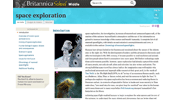Product Review: Britannica School

By MaryAnn Karre
Britannica School is a new online information solution designed for classrooms in grades preK-12 that provides multimedia resources for lessons and lesson planning, curriculum support, student and teacher research, and homework help.
Quality and Effectiveness
Britannica School streamlines student research, while providing multiple opportunities for differentiated learning. Through one portal, students can search articles, images, videos, dictionary, magazines, Web's Best Sites (with a snapshot of each Web page), primary sources and ebooks through Project Gutenberg, study guides and the Year in Review Timeline. At this time, over 140,000 articles of informational text, all aligned to the Common Core and State Standards, and thousands of video, audio, maps, illustrations, and photos are available to view and download. According to Britannica, thousands of articles, images, and multimedia elements are added every quarter.
Students also have access to resources to help them create projects; there are Research Planning Guides, support and guidance for writing book reviews, presentations, research papers and science reports. Tools for research include a world atlas, a one-to-one comparison of any two countries, Tour the U.S.A., and a link to My Content, where the user can gather and organize content, and where teachers can create and save lesson plans. Students can save any article, image or video to a list of favorites, for quick future access, or, a page in Britannica can be easily emailed to another person. Secondary users can cite articles quickly, in a variety of commonly-used styles, as Britannica will correctly format the citation for any article or image.
For educators, there are study guides, interactive lessons, visual learning and engrossing manipulatives; a lesson planning tool makes lessons easy to create with simple templates, curriculum standards, and links to Britannica content. Lessons can be edited, saved and shared with simplified URL.
Ease of Use
Perhaps Britannica School’s most attractive feature is its ability to differentiate content for the individual learner in so many ways. There are three levels of material, plus Britannica Learning Zone for PreK-2 offering learning materials for every student.
All article results are labeled with reading level indicators, which make it easy to select the portal appropriate to each student’s reading, grade, and age level; students and educators can easily move from one to another by selecting the levels that they would like to search in the upper left-hand corner of the search results page. Middle and high school level users can access content from all three databases from the search results page; in the elementary level, access to other reading levels is available on individual article pages. More importantly, struggling middle school and high school readers can view the content of a lower level within the interface of their grade level, keeping up pretenses while being able to tailor the material to their ability. Font size is easy to increase or decrease and the text in the middle and high school content can be translated into over 50 languages, using a Google translator. A simple click allows the student to hear a text-to-speech audio version of the text, and each word can be highlighted to increase comprehension. Double-clicking on ANY word in Britannica’s site triggers an audio pronunciation and definition of that word.
Tech & Learning Newsletter
Tools and ideas to transform education. Sign up below.
Some may find that searches are not as specific as students may like, especially when researching narrow topics or events; search results are more likely to return related topics when two or more terms are used in a search, or to refer to articles in which the search term can be found.
Creative Use of Technology
Because it is an online tool, Britannica can be viewed on any Internet-capable device, and the display will automatically adjust for optimal viewing on any screen, from the largest computer monitor to an iPad or smartphone, with equal clarity and readability, and with all accessibility tools. Students can explore and browse through broad subject heading or search for specific topics; once they find an article, an icon allows them to tag favorites, share via email, add to a bibliography, hear the article read aloud as it is highlighted, and view any related images, videos or articles.
Suitability for Use in a School Environment
Since students can access resources from a variety of sources, including journals, websites, multimedia and primary sources in addition to the encyclopedia articles, Britannica School promotes well-rounded research, and allows students to make connections between related topics. Lesson-planning and interactive resources help teachers supplement lessons with interesting and standards- based materials. By providing a variety of text complexity and multimedia content, Britannica School supports the Common Core Standards, which stipulate that students be able to read complex informational text, collect, analyze and evaluate diverse text and multimedia resources.
Top features:
- Britannica School supports differentiated instruction and is designed to enable students to move to higher or lower reading levels easily, and to be able to listen to or explore definitions of confusing text.
- It provides a wide range of resources such as encyclopedias, journals and periodicals, atlases, primary sources and multimedia, quickly accessible through a consolidated search feature, and all equally usable on any digital device, reducing the need to purchase multiple databases to support curriculum and allowing schools to use more mobile devices.
- Britannica School provides current, authentic content, which is edited and reviewed regularly by leading content experts, on subjects that are aligned to the new Common Core State Standards, and enables teachers to build lessons around those standards.
